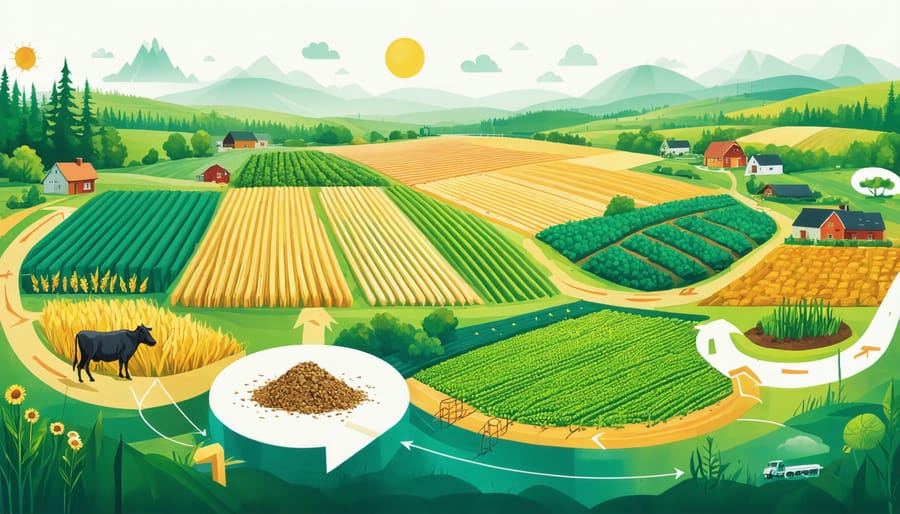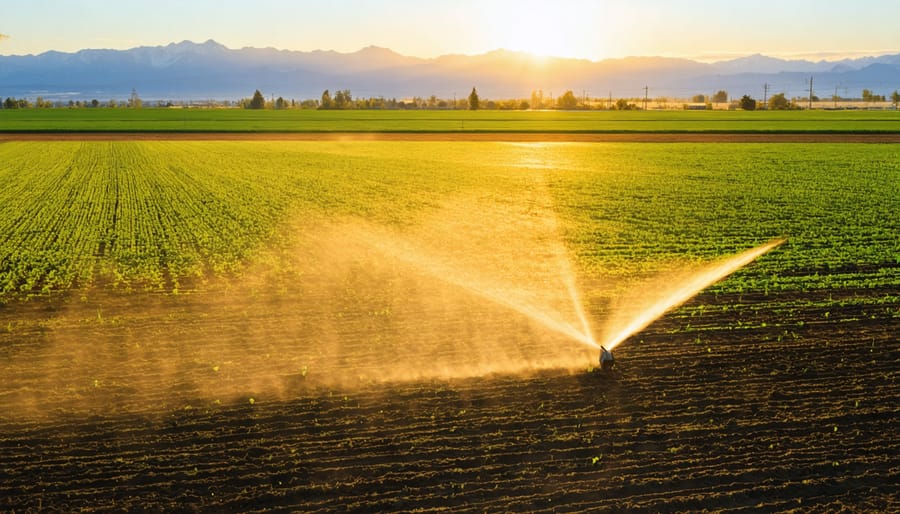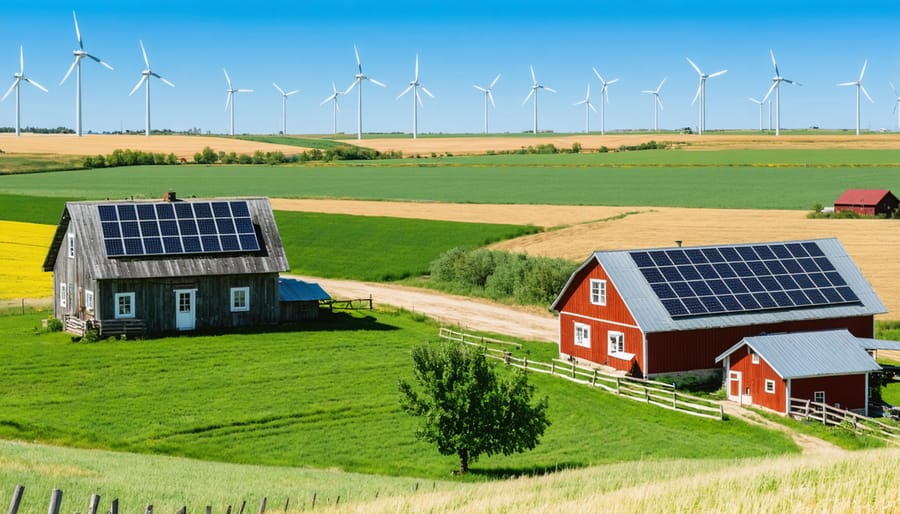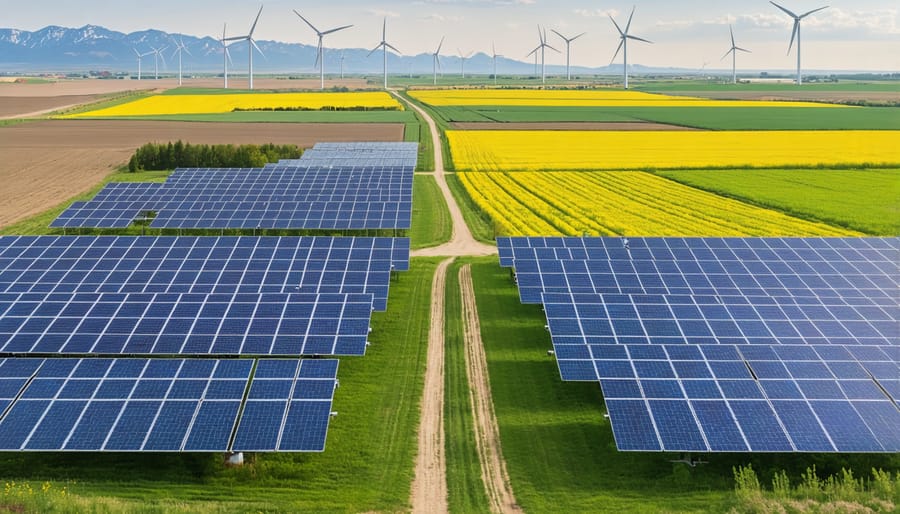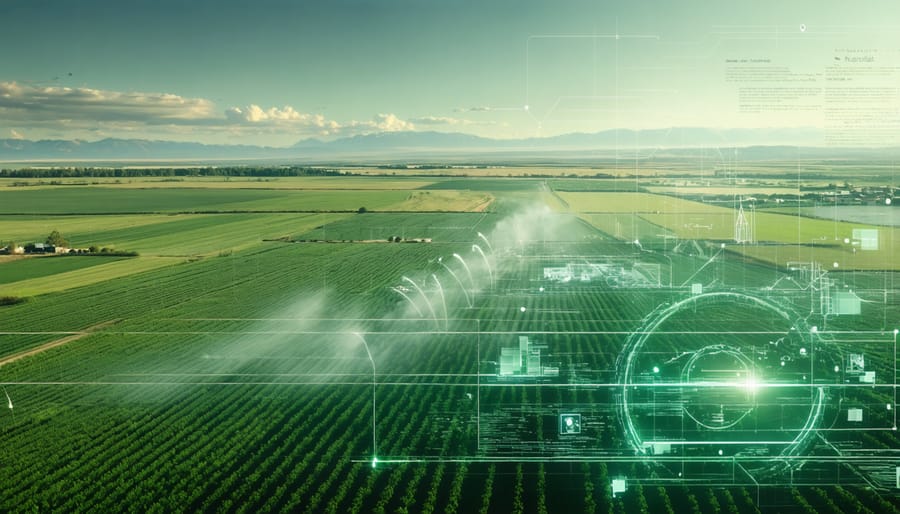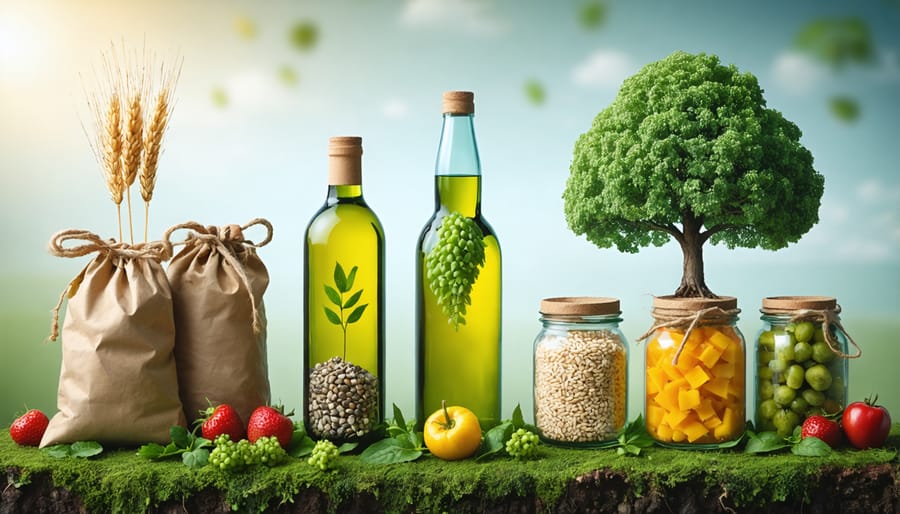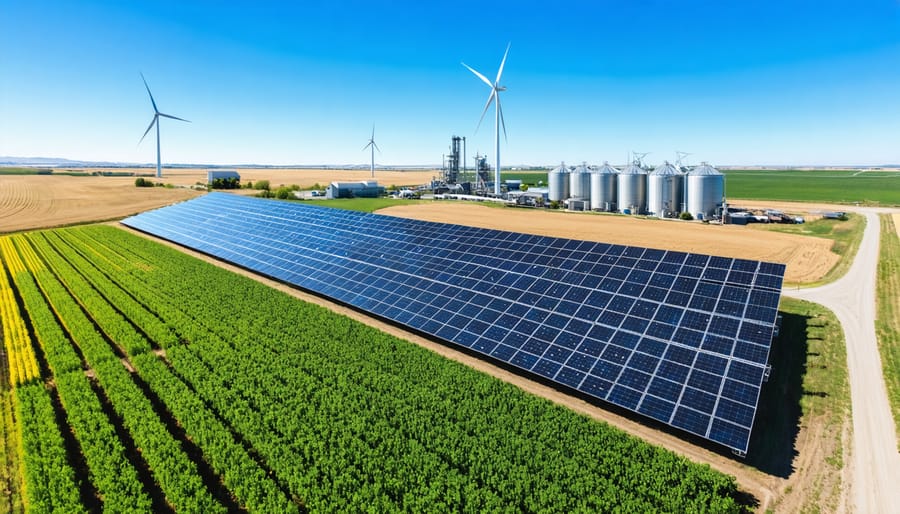The circular flow model revolutionizes how we understand modern agricultural economics, connecting farm operations directly to broader market dynamics. Here in Alberta, this economic framework illuminates the powerful relationships between producers, processors, and consumers that drive our $9.68 billion agricultural sector. When farmers grasp how resources, money, and goods flow between households and businesses, they can make more strategic decisions about production timing, market engagement, and supply chain optimization.
Picture your farm as part of an interconnected system where every output becomes another operation’s input. Your grain harvest feeds local livestock operations, while their manure fertilizes next season’s crops. This closed-loop thinking has helped Prairie farms reduce input costs by up to 25% while opening new revenue streams through resource recycling and waste reduction.
The model’s practical application extends beyond individual farms to strengthen regional agricultural communities. By understanding these economic relationships, Alberta producers have developed thriving local food networks, cooperative equipment-sharing programs, and innovative waste-to-resource initiatives that benefit everyone in the cycle. This isn’t just theory – it’s a blueprint for building more resilient and profitable agricultural operations in our changing economic landscape.
The Power of Rural Circular Economics
Traditional vs. Circular Agricultural Models
Traditional farming often follows a linear “take-make-dispose” model where resources flow in one direction: seeds and inputs are purchased, crops are grown and harvested, and waste materials are discarded. This approach, while familiar, can lead to soil degradation and increased dependency on external inputs.
In contrast, circular agricultural models transform waste into valuable resources. Here in Alberta, innovative farmers are leading the way by implementing practices like composting crop residues, using livestock manure as fertilizer, and rotating crops to maintain soil health. For example, the Henderson family farm near Red Deer reduced their input costs by 30% after adopting circular practices, including on-site composting and integrated livestock-crop systems.
The circular approach mimics natural ecosystems where nothing goes to waste. Crop residues feed livestock, manure enriches soil, and cover crops protect and nourish the land between growing seasons. This system not only reduces costs but also builds resilience against market fluctuations and weather extremes. Many Alberta farmers report improved soil quality and water retention within just a few years of transitioning to circular methods.
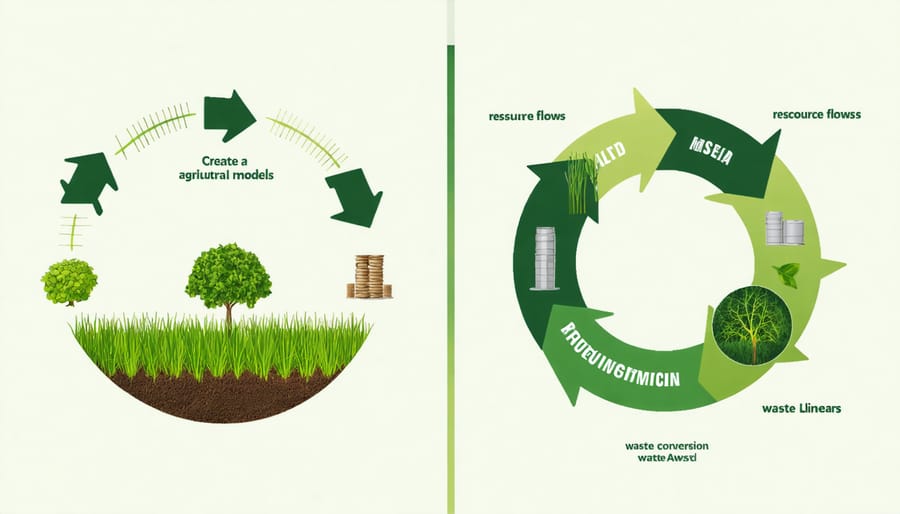
Economic Benefits for Alberta Farmers
Alberta farmers implementing circular economy principles are discovering significant financial advantages through diverse revenue streams and cost reductions. By adopting profitable soil management practices, farmers are seeing up to 20% increases in crop yields while reducing input costs.
The circular model creates new income opportunities through waste-to-resource conversion. Crop residues can be processed into valuable products like biochar or animal feed, while livestock manure becomes premium organic fertilizer. Local farmers report saving an average of $75-100 per hectare on fertilizer costs through these practices.
Value-added processing of agricultural by-products opens additional market channels. For example, some Alberta grain farmers are partnering with local breweries to convert excess grain into craft beverages, while others are creating compost for nearby market gardens.
The model also strengthens regional food security, allowing farmers to command better prices in local markets. By closing resource loops within their operations, farmers typically see a 15-25% reduction in operational costs while building more resilient and profitable enterprises.
Implementing Circular Flow in Your Farm Operation
Resource Mapping and Waste Assessment
Starting a resource mapping exercise on your farm is like creating a detailed inventory of what comes in and what goes out. Begin by tracking all inputs – from seeds and feed to fertilizers and fuel – and document how these resources flow through your operation. Make note of current waste streams, including crop residues, manure, and packaging materials.
Here in Alberta, many farmers have found success using simple spreadsheets or farm management apps to track these flows. For example, the Smith family farm near Red Deer discovered they could reduce feed waste by 30% just by mapping their livestock feeding patterns and identifying spillage points.
When conducting your waste assessment, consider these key questions:
– What materials currently leave your farm as waste?
– Which inputs could be sourced more sustainably?
– Where are the opportunities to close resource loops?
– What by-products could become valuable inputs for other processes?
Look for circular opportunities within your local farming community. Many Alberta producers have established successful partnerships where one farm’s waste becomes another’s resource. The Lethbridge region, for instance, has several examples of crop farmers using livestock manure from neighbouring operations as organic fertilizer.
Remember to involve your team in this process – often, workers on the ground have valuable insights about where resources are being lost or where improvements could be made. Regular reviews of your resource map will help identify new opportunities as they arise.

Creating Value from Agricultural Byproducts
Alberta farmers are discovering innovative ways to transform agricultural byproducts into valuable resources, creating new value-added agricultural opportunities while reducing waste. For example, the Lethbridge Biogas facility converts livestock manure and food processing waste into renewable energy, powering approximately 2,800 homes annually while producing nutrient-rich fertilizer as a secondary product.
Grain farmers across the province are finding creative uses for straw and chaff, with some partnering with mushroom growers who use these materials as growing substrate. Others are working with local construction companies to incorporate crop residues into eco-friendly building materials, creating additional revenue streams while reducing field burning.
In the Peace Country region, innovative producers are transforming damaged or unsold root vegetables into livestock feed supplements, while others are processing potato waste into biodegradable packaging materials. Several dairy farms have installed anaerobic digesters to convert manure and expired milk into biogas and organic fertilizers, demonstrating how waste streams can become profit centers.
These circular solutions not only create new income opportunities but also strengthen community relationships as farmers work together to maximize resource efficiency. Local success stories show that even small-scale operations can benefit from implementing these practices, with many reporting 15-20% increases in overall farm revenue through byproduct utilization.
Building Local Supply Chains
Building strong local supply chains is fundamental to creating a resilient circular economy in Alberta’s agricultural sector. By developing partnerships within your community, you can create sustainable networks that benefit everyone involved while reducing transportation costs and environmental impact.
Start by mapping out potential partners within a 100-kilometre radius of your operation. Consider local feed suppliers, equipment dealers, processors, and other farmers who might be interested in resource sharing or collaborative ventures. The Leduc Food Processing Development Centre, for example, has helped many Alberta farmers connect with local processors to transform their raw products into value-added goods.
Farmers’ markets and community-supported agriculture (CSA) programs offer excellent opportunities to establish direct relationships with consumers. The Alberta Farmers’ Market Association reports that markets generating over $1.5 million annually for local economies while strengthening community bonds.
Consider joining or establishing a producer cooperative. The Westlock Terminals, a farmer-owned grain handling facility in northern Alberta, demonstrates how local partnerships can create efficient supply chains while keeping profits within the community.
Don’t overlook digital platforms that can help connect you with nearby partners. Online marketplaces and agriculture-specific networking tools make it easier than ever to find and maintain local business relationships. Remember to document your partnerships and regularly assess their effectiveness to ensure they continue meeting everyone’s needs.
Real Success Stories: Alberta’s Circular Pioneers
The Morrison Farm Revolution
The Morrison family farm in Red Deer County stands as a shining example of successful Alberta farm transitions to circular economics. In 2018, Sarah and James Morrison transformed their traditional 400-hectare grain operation into a closed-loop agricultural system that now serves as a model for sustainable farming practices across the province.
By implementing innovative waste reduction strategies, the Morrisons created a system where their cattle operation’s manure fertilizes their grain fields, while crop residues feed their livestock. They installed a biodigester that converts organic waste into renewable energy, powering their farm operations and reducing annual energy costs by 65%.
The farm’s water management system captures and recycles rainwater for irrigation, while carefully planned crop rotation maintains soil health naturally. Through partnerships with local food processors, they’ve established a network where processing by-products return to the farm as animal feed supplements.
The results speak for themselves: soil organic matter has increased by 2.5% in three years, water usage has decreased by 40%, and overall farm profitability has improved by 30%. The Morrisons now host monthly workshops for neighbouring farmers, sharing their experiences and helping others implement similar systems in their operations.
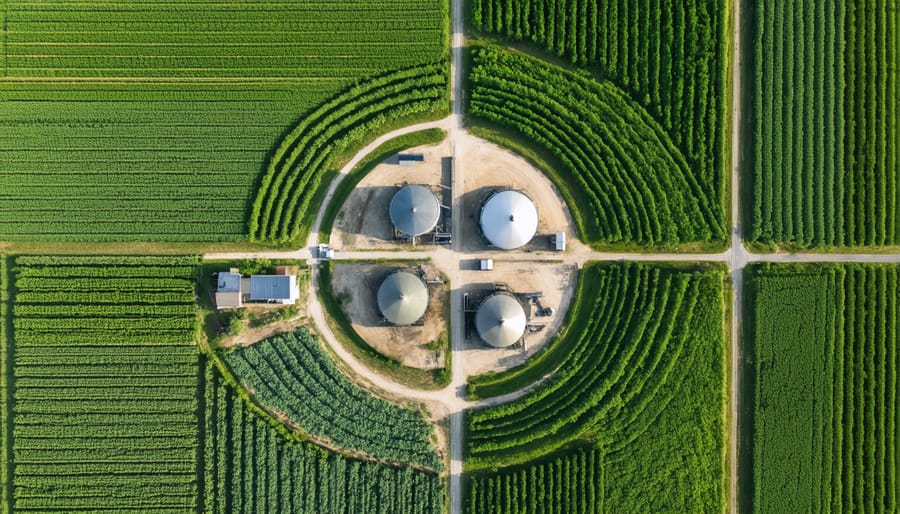
Community-Wide Impact in Red Deer County
The implementation of circular flow practices in Red Deer County has created ripple effects that extend far beyond individual farm boundaries. Local studies show that farms adopting these principles have collectively reduced their waste output by approximately 30% over the past three years, leading to significant cost savings and environmental benefits for the entire region.
The County has seen improved soil health across participating properties, with organic matter content increasing by an average of 2% in tested areas. This enhancement has contributed to better water retention and reduced runoff, benefiting downstream communities and supporting local watershed health.
Local agricultural suppliers have adapted their business models to support this circular approach, creating new jobs in waste management, composting facilities, and sustainable input production. The Red Deer County Agricultural Services Board reports that these changes have generated over 50 new positions in the agricultural sector since 2020.
Community collaboration has strengthened as farmers share equipment, exchange materials, and participate in knowledge-sharing networks. The local farmers’ co-op has expanded its membership by 25%, facilitating easier resource sharing and collective purchasing power for sustainable materials.
Environmental improvements are evident in reduced chemical runoff into local waterways and decreased greenhouse gas emissions from agricultural operations. The County’s annual environmental assessment shows a 15% reduction in agricultural-related emissions compared to 2019 baseline measurements, demonstrating the tangible benefits of circular economic practices for our community’s future.
Getting Started: Your First Steps
Available Support and Resources
Alberta farmers looking to implement circular flow practices can access numerous financial support programs and resources through provincial and federal channels. The Environmental Farm Plan (EFP) program offers guidance and funding for sustainability initiatives, while the Canadian Agricultural Partnership (CAP) provides grants for innovative farming practices.
Local agricultural extension offices throughout Alberta offer free consultations with experts who can help assess your operation’s potential for circular systems. The Alberta Farm Sustainability Extension Working Group (AFSEWG) hosts regular workshops and field days, connecting farmers with experienced practitioners and researchers.
Technical support is available through organizations like SARDA Ag Research and Lakeland Agricultural Research Association, which offer soil testing services and personalized recommendations for resource optimization. The University of Alberta’s Faculty of Agricultural, Life & Environmental Sciences provides research partnerships and demonstration projects for interested farmers.
Additionally, mentor networks through Alberta Farm Fresh Producers Association pair experienced circular economy practitioners with those just starting their journey, fostering knowledge sharing and community support.
Planning Your Transition
Starting your journey toward a circular farming operation doesn’t have to be overwhelming. Begin by conducting a thorough assessment of your current resource flows, including inputs, outputs, and potential waste streams. Map out where materials enter your operation and where they exit, identifying opportunities for closing loops.
Next, set realistic goals that align with your farm’s capacity and local conditions. For example, if you’re managing a grain operation near Lethbridge, consider how you might incorporate livestock to utilize crop residues, or partner with nearby producers to share resources.
Create a timeline for implementing changes, starting with quick wins that require minimal investment. This might include establishing a composting system for organic waste or exploring water recycling methods. Remember to involve your team in the planning process – their practical insights are invaluable.
Connect with local agricultural extension services and fellow farmers who have experience with circular practices. The Alberta Farm Sustainability Extension Working Group offers excellent resources and networking opportunities. Document your baseline metrics so you can track improvements and adjust your approach as needed.
Start small, learn continuously, and build on your successes as you transition toward a more circular operation.
The circular flow model offers tremendous potential for Alberta’s agricultural community, presenting a pathway to both environmental stewardship and economic prosperity. By embracing these principles, our farms can reduce waste, maximize resource efficiency, and create new revenue streams while contributing to a more sustainable future for Canadian agriculture.
Throughout Alberta, we’re already seeing inspiring examples of farmers implementing circular practices, from converting agricultural waste into biogas to establishing local composting networks. These success stories demonstrate that the transition to circular farming isn’t just theoretical – it’s a practical and profitable reality for many in our community.
The benefits extend beyond individual farms, strengthening our rural communities through increased collaboration and resource sharing. By working together, we can create resilient local food systems that support both our economy and environment.
Taking the first step toward circular farming doesn’t have to be overwhelming. Start small by identifying one area where you can close a resource loop on your farm. Connect with local agricultural extension services, join farmer-led initiatives, or reach out to neighbors who have already begun their circular journey.
Remember, every step toward circularity, no matter how small, contributes to a more sustainable agricultural sector in Alberta. The future of farming is circular, and together, we can lead the way in transforming how we produce food while preserving our land for generations to come.

